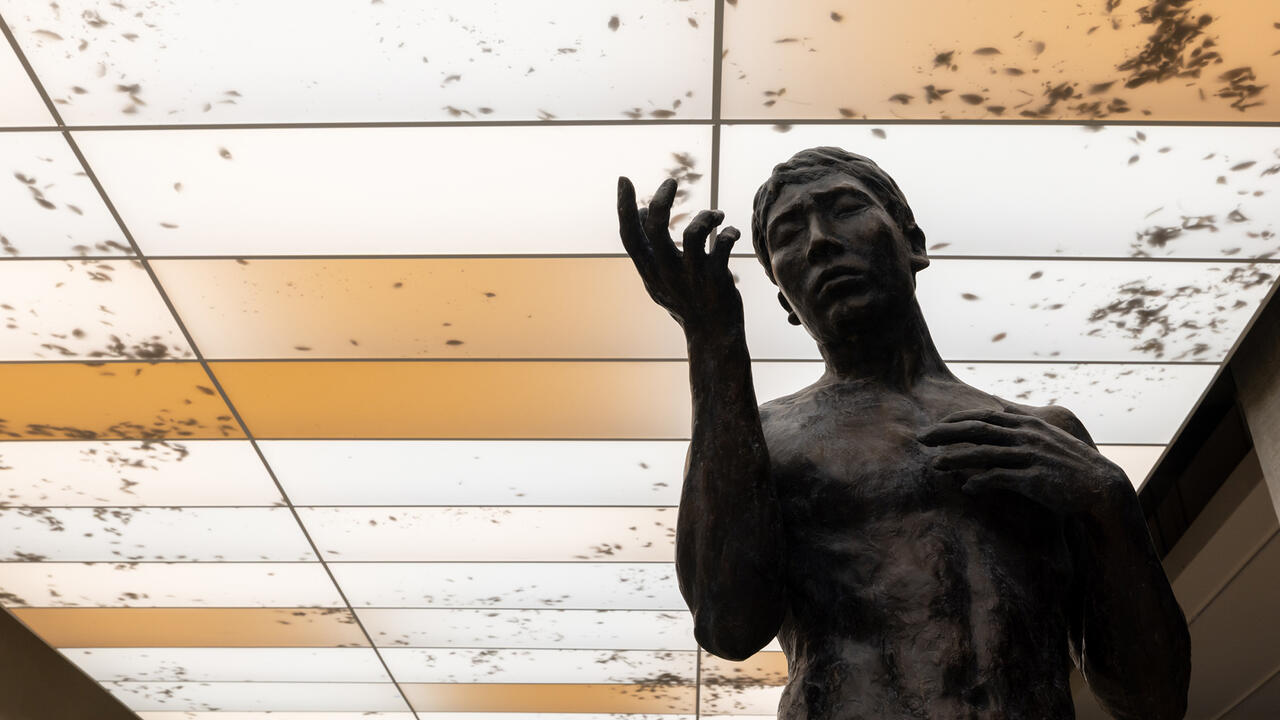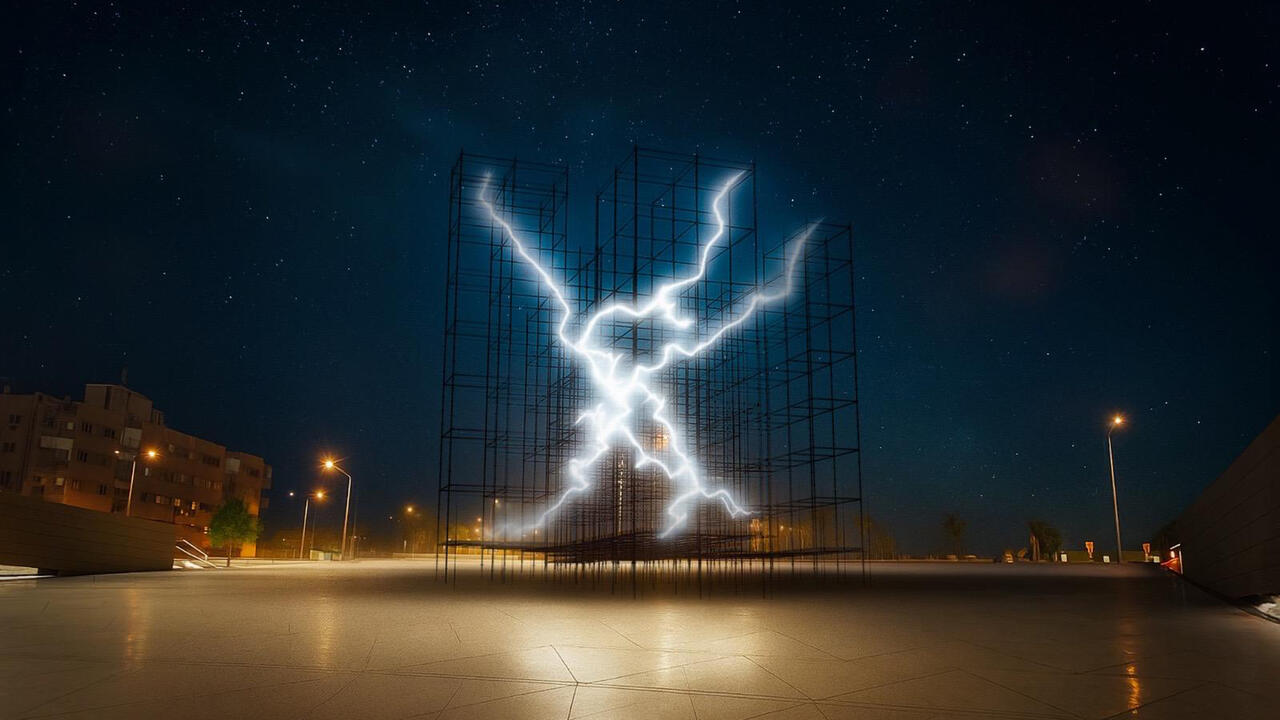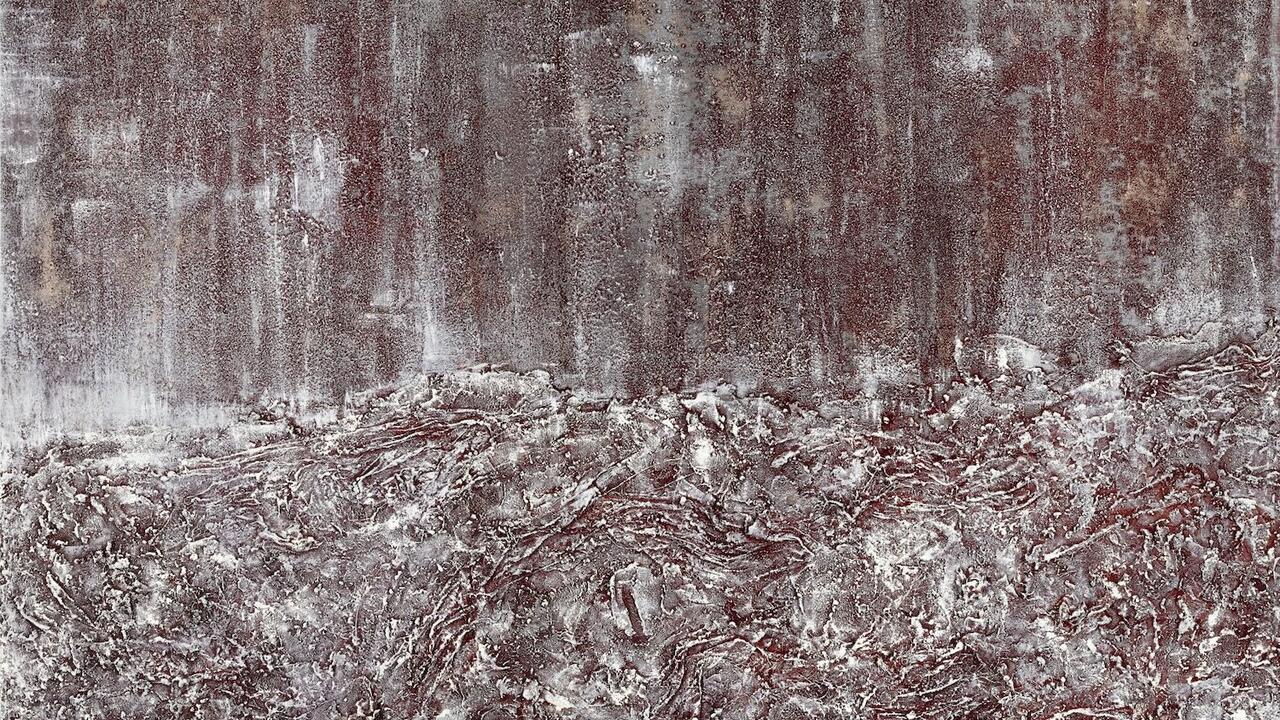What's Love Got to Do With It
Felix Gonzalez-Torres
Felix Gonzalez-Torres
Your turn. Look hard and tell us what you see in this 1992 poster by Felix Gonzalez-Torres. Roughly three by four feet in size, all it displays is a field of red framed by a two-inch-wide white border. Painted on canvas, such an abstract image might appear more tight-lipped, more like an inaudible, uniquely visual event. But as a poster, it can't help but propagandise; here a message is being repeated to you, being spread. The red is clean and saturated, the colour of fire trucks, or of an intense passion, albeit one hemmed in by the white border's stately demeanour. We're talking about a serious emergency, a righteous cause. Right?
'Right-ee-o,' says Felix the Cat; sure enough, a year before, in a piece he scattered on a number of billboards around New York City, the same design was adopted as a backdrop for a text: 'Health care is a right...no excuses,' the signs stumped in both English and Spanish. So why does a completely different sense of urgency inflame the 1992 poster? Not because it lacks words; the biggest change, in fact, is its title, and these new words are what profoundly re-orient the red's deeply-held feeling, the elegant border's hint of higher purpose and resolve, the poster's generally intimidating facelessness. The crisis now shifts in shape, the either sides of the struggle rewrite their agendas, and a new justification is found for the violence that looms between them. All this wreaked upon the poster's vulnerable image by its name, which Gonzalez-Torres drops casually, as if in a whisper. Untitled (National Front), the poster's called.
Take your pick. An angry protest against the US domestic policy of murder by neglect, or perhaps a silent acknowledgement of the British or French political crusades to stoke the hysterics of racial hatred. Whatever, the red-and-white poster seems to shrug. No one answer to Gonzalez-Torres' multiple choice questions is more accurate than any other: the celebrations he stages are tailored to fit many occasions, like so many uninscribed Hallmark cards, didactic material sandblasted down to its visual architecture. Admirers nod that the work is open-ended - to a fault, detractors agree. Gonzalez-Torres can only plead guilty: his art promises content but also refuses to guarantee its delivery.
And that seems the point. His piles of complimentary candies and bottomless stacks of souvenir posters, his lists of commemorative dates and strands of party lights - all appear formally attired at first glance but quickly lose their composure, running on at the mouth, collapsing in corners, swinging from rafters, seeping across floors; all explode firework-like but soon fizzle away, sparking our curiosity only to send it wandering off. His Rorschach-blot art begs to be emotionally invested - like a waiting embrace, you faint in its arms, it melts in your mouth, but it never holds or concretises the investment. Instead it allows that emotion to pour molten over the surroundings, to overwhelm or be contained by the architecture, to run up against its history and administration, the title plaques, the checklist, the art world's unwritten code of conduct, and so on; to be sculpted in the same way as public opinion and popular taste, by the media, culture, ideology. Rather than spoon-feed fully baked dissent to his audience, Gonzalez-Torres touches on topics ever so lightly; it's more important that his work touch us and in turn bring us in touch with the variety of institutional forces that shape our experience.
Speaking of spills, in the last year what was a trickle of ink devoted to Gonzalez-Torres' work has burst into a flash flood. Among the just-dried printed matter is a featured section in a recent issue of Parkett and a handsome new book published by Art Press. Plus the artist has embarked on something like a US tour, mobilising a project that hops the country from West to East coast then pulls to stop in the Midwest. It's the first major museum presentation of Gonzalez-Torres' art, and he's spread the event into three distinct exhibits, the first mounted at the Museum of Contemporary Art in Los Angeles, the next in Washington D.C.'s Hirshhorn Museum, and the last at the Renaissance Society in Chicago. Peeling out in the spring, the travelling show stays on the road over the summer and fall, and is titled, simply enough, 'Traveling.'
The bold decision to hang - or pour - a different exhibit in response to each of the three venues was perhaps made out of necessity as much as anything. Organising a standard mid-career retrospective of Gonzalez-Torres' output would like trying to hammer a timeline or measuring stick out of a slinky. Recycling, overlapping, repeating, simultaneously looking forward and back - these terms not only physically describe his work but represent some of its major themes. Most of Gonzalez-Torres' art conforms to a few fairly set formats. Since 1986 he's produced word portraits, significant events converted into titles and dates and listed in a crisscrossing, non-chronological order, then presented either in frames, where they caption all-black backgrounds, or painted directly onto the walls. There are also the stacks of paper he's made since 1988, and the candies piled in corners or spread in rectangles or squares on the floor, which date from 1990 to the present. For the past three years we've also seen the strings of lights, most of which consist of 42 15- or 25-watt bulbs linked by a 42 foot white extension cord, and whose installation the artist leaves up to the work's owner or curator.
It's impossible to even imagine, let alone appreciate, Gonzalez-Torres' artworks in isolation. They get absorbed almost entirely by whatever environment they're placed in. (This may or may not have something to do with the fact that the artist doesn't have a studio, and ends up making major decisions about his work during its installation.) Pieces are often stitched into the architecture; besides using corners and floors, Gonzalez-Torres hangs drapes over windows, as in Untitled (Lover Boy) (1989), or hangs beaded curtains in passageways, as in Untitled (Blood) (1992). Even pieces with the warmest romantic blush remain clasped to their institutional contexts: Untitled (Orpheus, Twice) (1991), literally reflects its surroundings, its two full-length mirrors not set against the wall but actually inset flush with it. Likewise, Untitled (Perfect Lovers) (1987-1990), in which two commercial clocks, mounted side by side and telling nearly the exact same time down to the second, suggest sweethearts whose throbbing for each other gets measured out in the museum's bureaucratic, standardised cadence.
Like an office party flirt with no steady job, Gonzalez-Torres' art manages to come across as both intimate and chamelion like, re-inventing itself not just from site to site but from moment to moment. The webbing of his commissioned word portraits gets endlessly re-spun, each beginning with a list provoked by the work's owner of important personal incidents to which the artist then adds historical events of direct and indirect relevance (along with some of the more significant shows MOCA's mounted, the museum's portrait included 'Rodney King 1992, Waterbeds 1971, MTV 1981' etc.). But the owner is also invited to insert or delete elements from the list at any time. And then, of course, there's Gonzalez-Torres' cross-dressed Minimalism, his amassings of sweets and posters that, despite their hard-edged arrangements, never lie dead still, but instead seem to pulsate, to rise and fall in slow, heavy sighs as they get peeled and picked away by visitors then restocked by museum personnel. The work comes on strong, giving itself up for free; it strains in the hope that, with enough onlookers enjoying its offerings, it in turn will be literally swept off its feet.
In the battle-scarred field of cultural activism, Gonzalez-Torres' chooses to arm himself with bouquets of flowers and heart shaped candy-grams, to construct booby traps out of mistletoe: his matchmaker art seeks to establish firm ties to both its audience and its institutional setting, to bring the two into a tight, volatile relationship. Both physically and metaphorically touchy, his work labours to heighten not just our passions but also our awareness of the framework imposed on those passions. As he co-ordinates the steady ticking of his clocks and the slow respiration of his piles and stacks with emotional ups and downs, hope and loss, inspiration and despair, feeling moved gets equated with actual movement, with sensing one's place in the world somehow changed, or at least leaning toward change. Like a maypole on wheels, his work keeps the myriad attachments leashed to it in constant, kaleidoscopic motion, and it's this kind of movement - rather than the transitions or breakthroughs internal to the artist's career - that preoccupies the three exhibits comprising 'Traveling.'
Only two pieces, Untitled (Perfect Lovers) and Untitled (Orpheus, Twice), survived the trip from MOCA to the Hirshhorn unchanged. Otherwise the listed historical dates, the piles, et al., underwent telling yet subtle shifts in temperament. Relatively underlit and more compact, the MOCA installation came across as a splash of cold reality aimed at SoCal's sunny facade. The show included two of Gonzalez-Torres' most depressing poster stacks, the stoic red and black Untitled (NRA) (1991), and the grimly verbose Untitled (Death by Gun) (1990), the latter tallying up an average week's worth of America's bullet-ridden dead. At the nation's capital, a city buried beneath grey concrete and red tape, Gonzalez-Torres opted against doing a word portrait of the hosting institution in favour of a self-portrait; among other things, a beaded-curtain piece was added to the ensemble, and though twice as big as its predecessor the show seemed more bright and personal. Still to come, the Chicago exhibit is likely to feature blue window drapes (drawn, of course) and a lit dancing platform, suggesting a disco or strip joint, still more venues where the public and private regularly meet.
While it's true that, before anything else, Gonzalez-Torres wants his art to be taken to heart, taken personally, he in no way limits himself to strictly private matters. When privacy gets explicitly referred to in his work, it's usually a discriminatory label affixed by the state in the name of public interest, national security, the free market, etc., or a means to justify some sort of inequity, whether it's private ownership's steady encroachment into the public domain, or extension of the right to privacy only to straights (as per the Supreme Court's 1986 decision in Bowers v. Hardwick). He has also dealt with the designation as private, which is to say the condemning to privation, of the thought and behaviour that for a vast number of people forms the core of their experience, but that's construed by the powers that be as subversive. Defying such institutionally enforced estrangement, Gonzalez-Torres stages a public protest by refusing to remain a stranger, not keeping private his desires, fears, enthusiasms and outrage.
Certainly his artworks refuse to keep to themselves. For one thing, when they do picture private space it's always inhabited by more than one person. Private sanctuaries serve as meeting grounds and vice versa: in an untitled billboard piece from 1991, Gonzalez-Torres displayed an image of an empty bed whose two pillows are left imprinted by the resting heads of it's now-departed occupants. A lone viewer of Untitled (Orpheus, Twice) has the choice of either uniting the work's two mirrors by allowing his or her reflection to be split between them, or to unite his or her own image only to leave one mirror with an absent partner. And in a 1992 image of what should be ultimate and permanent solitude, Gonzalez-Torres photographs fresh flowers laid over a grave site, except that, as the title informs us parenthetically, the grave is shared by two lovers, Alice B. Toklas and Gertrude Stein.
Formally, Gonzalez-Torres' works don't stake out their own turf, don't lay claim to an inviolate space - as his heaps of paper and treats emphasise, they are not self-contained. And as a result, they stray from the aim of much political art today, which is to claim a self-possessed identity. To do so would be to pre-empt the institutions Gonzalez-Torres seeks to infiltrate only by doing their dirty work for them, to assume the job of typecasting and objectifying himself (a star is self-born - 'Next on Oprah: Gay Cuban-American artists who like to give candy to strangers!') It's as if, in a sense, Gonzalez-Torres wants his coming out to never be complete.
Which is why his work is sometimes sniffed at disapprovingly. Yet the criticism mounted by some content-mongers - that Gonzalez-Torres is too ill-defined, vacant, too obsequious and ingratiating, too warm and fuzzy - echoes ironically the attacks launched by the champions of High Formalism against Minimalism. Granted, it's a stretch to describe Minimalism's stacked bricks, loitering steel plates, Plexiglas and Formica boxes, and butted together copper tiles as warm and fuzzy; indeed, it was the stated intent of Minimalism's practitioners to reject illusionism by making an art so obdurate it had to be taken at face value, an art no-one could possibly imagine harboured an inner life or possessed some spirit of thought or creativity. But that's exactly how Minimalism pandered to its audience - with nothing to point in toward, it could only point out. Lacking an internal life meant that it was without an interior linchpin for its compositions; its stacks and rows of bland, prosaic units could seemingly go on forever - just 'one thing after another' as Donald Judd put it - and therefore it gained definition from without, from its situation, from the architecture, the light as it shifted over the course of the day, and, in the end, from the field of vision that all these things occupied but that was ordered ultimately by the viewer. The formalist Michael Fried complained in 1967 that, confronted by a Minimalist object, the beholder was made to feel 'as though [it] has been waiting for him.'
Gonzalez-Torres' art too houses an empty centre, depends for its meaning on its relationship to things outside it, and desperately pines for the viewer. The biggest difference is that his work sheds its aloofness much more wilfully and immediately. It doesn't pretend to be either literally or figuratively dense, doesn't try to stop the viewer's inquiry at its material surface - there is a space for projection that Gonzalez-Torres opens within his art; though an emptiness, it is a weighted one, a need. In a manner similar to Robert Gober and Charles Ray, Gonzalez-Torres flushes his work clean in order to render it not more innocent but more impressionable, more prone to inflection, to registering the effects of its situation, including the viewer's projection onto it. If the works do embody anything, it's not meaning so much as our desire for it - reaching out to its audience, begging to be ravaged, the work can never give itself up completely, never give up to us the satisfaction it seems to promise over and over. Though angled towards us, there's always something just beyond or absent from the work, as if its content, or at least its completion, lies elsewhere: the view out the window behind his drapes, the rooms beyond his beaded-curtain doorways, the blank expanses in his captioned photos, not to mention the heaped posters and candies, objects that have no real backsides or bottoms, no concluding terms, just endlessly repeating first impressions. Each sculpture can only give itself up to us as an image, and is in turn eclipsed by that image - a token, a fragment, a semblance of a whole that can't be known except through semblances, that doesn't really exist but is simply desired.
Gonzalez-Torres always describes an 'ideal' dimension whenever displaying one of his stacks (or, in the case of some of the candy pieces, an 'ideal' weight). He then adds that these works are infinitely reproducible. So the 'ideal' version of each sculpture has never really existed outside its limitless representations, can never be anything but lost, and therefore can never be found for good, only glimpsed again and again. This is how Gonzalez-Torres revs up the machinery of desire; like cornucopias spilling only broad crumbs, his sculptures recede endlessly as they're pursued, displaced by our projections of the compensation we're forever looking for, absenting themselves so that desire may flow objectless, desiring only itself. What he offers are literally sweet nothings, impressions and aftertastes, longings and remembrances, things repeatedly used though they serve no utilitarian purpose. While outgoing, his works stubbornly hold something of themselves back; they refuse to give themselves up as thoroughly explicit, finished products. And by unleashing a sense of something not yet attained, and hence the desire for it, Gonzalez-Torres sends a shudder through the museum's static, institutional confines, unsettling its fixed laws, its pre-cooked meanings, its blueprint of a fully formed, limited world. Within this sealed universe, his artworks appear like both oases and ruins, formations at once plentiful and perishing, sites where the surplus of our hopes and deficit of our needs find daylight and march out into the open.
Not only in his 'infinitely reproducible' sculptures, but in most all of his work, Gonzalez-Torres attempts to fulfil the prophesy Walter Benjamin made in his 1936 essay 'The Work of Art in the Age of Mechanical Reproduction.' Foreseeing the dissolution of the authentic, one-and-only artwork through the proliferation of its photo-mechanical copies, Benjamin diagnosed the resulting loss of that artwork's 'aura,' which he described as its unapproachability, its sense of being so self-possessed, so anchored in its own time and place, as to attain its full autonomy. Benjamin speaks of 'the desire of contemporary masses to bring things "closer,"' a desire the auratic object frustrates, treats as a handicap it is not burdened by - we desire it, but it needs nothing. Images of autonomy appear throughout Gonzalez-Torres' work, only to be unravelled: 'Nowhere better than this place' is the text offset on the posters of one of his stacks, which is set alongside another set of posters that read 'Somewhere better than this place.' His word portraits detach unique moments from their fixed place in time, so that they may be relived - remembered - in infinitely changing ways according to the relationships they strike up with other events, both present and remembered. And when he butts two clocks together he literally draws the image of infinity, a figure of eight, out of their two closed circles.
Against the auratic artwork's claim to creating its own significance, Gonzalez-Torres opens the manufacture of its meaning to outside contingencies. In this way, though it may seem awkward to suggest, his art seems inauthentic twice over: not only because it lacks an original, but because, though earnest and sincere, it can never once and for all mean what it says, since what it means is always provisional, reversible, kept fluid within the negotiations, the sharing between it and its viewer. At the very least, by welcoming the viewer's constant approach, Gonzalez-Torres' work responds affectionately to the desire Benjamin spoke of. Indeed his art is comprised entirely of tokens of that affection, given out in an acknowledgement of a hunger that, though insatiable, can be endlessly fed. Deliberately choosing not to render some definitive, one-and-only and once-and-for-all statement, Gonzalez-Torres instead devotes himself to preparing the way for a limitless chain of second cummings.
















